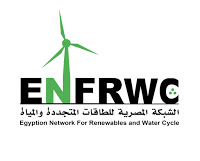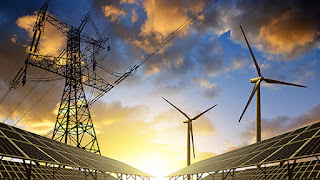الخميس، 27 يناير 2022
اخبار البيئة المصرية في يومها ٢٧ يناير ٢٠٢٢ Egyptian environment news on its day 27 January 2022
الاثنين، 17 يناير 2022
المركبات الكهربائية توفر انبعاثات كربونية أقل حتى مع إضافة سلاسل التوريد YSE Study Finds Electric Vehicles Provide Lower Carbon Emissions Through Additional Channels
With new major spending packages investing billions of dollars in electric vehicles in the U.S., some analysts have raised concerns over how green the electric vehicle industry actually is, focusing particularly on indirect emissions caused within the supply chains of the vehicle components and the fuels used to power electricity that charges the vehicles.
But a recent study from the Yale School of the Environment published in Nature Communications found that the total indirect emissions from electric vehicles pale in comparison to the indirect emissions from fossil fuel-powered vehicles. This is in addition to the direct emissions from combusting fossil fuels — either at the tailpipe for conventional vehicles or at the power plant smokestack for electricity generation — showing electric vehicles have a clear advantage emissions-wise over conventional vehicles.
“The surprising element was how much lower the emissions of electric vehicles were,” says postdoctoral associate Stephanie Weber. “The supply chain for combustion vehicles is just so dirty that electric vehicles can’t surpass them, even when you factor in indirect emissions.”
Weber was part of the study led by Paul Wolfram ’21 PhD — now a postdoc with the Joint Global Change Research Institute at the University of Maryland — and that included YSE economics professor Ken Gillingham and Edgar Hertwich, an industrial ecologist from the Norwegian University of Science and Technology and a former YSE faculty member. The research team combined concepts from energy economics and industrial ecology — carbon pricing, life cycle assessment, and modeling energy systems — to find if carbon emissions were still reduced when indirect emissions from the electric vehicle supply chain were factored in.
“A major concern about electric vehicles is that the supply chain, including the mining and processing of raw materials and the manufacturing of batteries, is far from clean,” says Gillingham. “So, if we priced the carbon embodied in these processes, the expectation is electric vehicles would be exorbitantly expensive. It turns out that’s not the case; if you level the playing field by also pricing the carbon in the fossil fuel vehicle supply chain, electric vehicle sales would actually increase”
The study also considered future technological change, such as decarbonization of the electricity supply, and found this strengthened the result that electric vehicles dominate when indirect supply chain emissions are accounted for
The research team gathered data using a National Energy Modeling System (NEMS) created by the Energy Information Administration, which models the entire U.S. energy system using detailed information from the current domestic energy system and a forecast of the future of the electric system. Wolfram completed a life cycle assessment that provided outputs of indirect emissions, which were then plugged into the NEMS model to see how a carbon tax on these indirect emissions would change the behavior of consumers and manufacturers. Weber assisted in modifying the NEMS code
According to Wolfram, the study shows that “the elephant in the room is the supply chain of fossil fuel-powered vehicles, not that of electric vehicles.” He notes that the faster we switch to electric vehicles, the better — at least in countries with a sufficiently decarbonized electricity supply, like the U.S.
Gillingham, whose research has focused extensively on alternative energy adoption in transportation, says this research provides a better understanding of how comprehensive carbon pricing — which includes the full supply chain — can shift consumers toward electric vehicles
مع حزم الإنفاق الرئيسية الجديدة التي تستثمر مليارات الدولارات في السيارات
الكهربائية في الولايات المتحدة ، أثار بعض المحللين مخاوف بشأن مدى اخضرار صناعة
السيارات الكهربائية في الواقع ، مع التركيز بشكل خاص على الانبعاثات غير المباشرة
الناتجة داخل سلاسل التوريد الخاصة بمكونات السيارة والوقود المستخدم في
الكهرباء التي تشحن المركبات.
لكن دراسة حديثة من
كلية ييل للبيئة نُشرت في Nature
Communications
وجدت أن إجمالي الانبعاثات غير المباشرة من المركبات الكهربائية شاحبة مقارنة
بالانبعاثات غير المباشرة من المركبات التي تعمل بالوقود الأحفوري. هذا
بالإضافة إلى الانبعاثات المباشرة من احتراق الوقود الأحفوري - سواء في أنبوب
العادم للمركبات التقليدية أو في مداخن محطة توليد الكهرباء لتوليد الكهرباء - مما
يدل على أن السيارات الكهربائية تتمتع بميزة واضحة فيما يتعلق بالانبعاثات مقارنة
بالمركبات التقليدية.
تقول
ستيفاني ويبر ، زميلة ما بعد الدكتوراه: "كان العنصر المثير للدهشة هو مدى
انخفاض انبعاثات السيارات الكهربائية". "سلسلة التوريد لمركبات
الاحتراق قذرة للغاية بحيث لا يمكن للسيارات الكهربائية تجاوزها ، في اسوء احوالها
، حتى عندما تأخذ في الاعتبار الانبعاثات غير المباشرة."
كان
Weber جزءًا من الدراسة التي قادها Paul
Wolfram '21 PhD
- وهو الآن ما بعد الدكتوراة مع معهد أبحاث التغيير العالمي المشترك في جامعة
ميريلاند - والتي شملت أستاذ الاقتصاد في YSE كين جيلينجهام وإدغار
هيرتويتش ، عالم البيئة الصناعية من الجامعة النرويجية العلوم والتكنولوجيا
وعضو هيئة تدريس سابق في YSE. قام فريق البحث بدمج
مفاهيم من اقتصاديات الطاقة والبيئة الصناعية - تسعير الكربون ، وتقييم دورة
الحياة ، ونمذجة أنظمة الطاقة - لمعرفة ما إذا كانت انبعاثات الكربون لا تزال
منخفضة عندما تم أخذ الانبعاثات غير المباشرة من سلسلة توريد المركبات الكهربائية
في الاعتبار.
يقول
جيلينجهام: "أحد الشواغل الرئيسية بشأن السيارات الكهربائية هو أن سلسلة
التوريد ، بما في ذلك التعدين ومعالجة المواد الخام وتصنيع البطاريات ، بعيدة كل
البعد عن النظافة". "لذا ، إذا قمنا بتسعير الكربون المتجسد في
هذه العمليات ، فإن التوقعات هي أن السيارات الكهربائية ستكون باهظة الثمن.
اتضح أن الأمر ليس كذلك. إذا قمت بتسوية ساحة اللعب من خلال تسعير
الكربون أيضًا في سلسلة إمداد المركبات التي تعمل بالوقود الأحفوري ، فستزيد
مبيعات السيارات الكهربائية بالفعل ".
نظرت
الدراسة أيضًا في التغيير التكنولوجي المستقبلي ، مثل إزالة الكربون من إمدادات
الكهرباء ، ووجدت أن هذا يعزز النتيجة التي تهيمن عليها السيارات الكهربائية عندما
يتم حساب انبعاثات سلسلة التوريد غير المباشرة.
جمع
فريق البحث البيانات باستخدام نظام نمذجة الطاقة الوطنية (NEMS) الذي أنشأته إدارة معلومات
الطاقة ، والذي يصمم نظام الطاقة الأمريكي بأكمله باستخدام معلومات مفصلة من نظام
الطاقة المحلي الحالي وتنبؤ بمستقبل النظام الكهربائي. أكمل ولفرام تقييم
دورة الحياة الذي قدم مخرجات للانبعاثات غير المباشرة ، والتي تم إدخالها بعد ذلك
في نموذج المخطط الأساسي الوطني لمعرفة كيف يمكن لضريبة الكربون على هذه
الانبعاثات غير المباشرة أن تغير سلوك المستهلكين والمصنعين. ساعد ويبر في
تعديل رمز NEMS.
وفقًا
لـ Wolfram ، تُظهر الدراسة أن "الفيل الموجود في الغرفة هو سلسلة
التوريد للمركبات التي تعمل بالوقود الأحفوري ، وليس المركبات الكهربائية".
ويشير إلى أنه كلما تحولنا بشكل أسرع إلى السيارات الكهربائية ، كان ذلك
أفضل - على الأقل في البلدان التي لديها إمدادات كهرباء خالية من الكربون ، مثل
الولايات المتحدة.
يقول
جيلينجهام ، الذي ركز بحثه على نطاق واسع على اعتماد الطاقة البديلة في النقل ، إن
هذا البحث يوفر فهمًا أفضل لكيفية تحويل تسعير الكربون الشامل - الذي يشمل سلسلة
التوريد الكاملة - الي تحفيز المستهلكين نحو استعمال السيارات الكهربائية.
الجمعة، 14 يناير 2022
في عام 2021 ، انخفاض الكهرباء من مصادر الطاقة المتجددة ، وزيادة استهلاك المازوت في إنتاج الكهرباء In 2021 , lower Electricity from Renewables , higher Mazout consumption in Electricity
قفز الاعتماد على المازوت لتوليد الكهرباء، نهاية العام الماضي، بنسبة 620% مقارنة بنهاية عام 2020، ليتراجع حجم الكهرباء المولدة من الغاز الطبيعي إلى 78.6% العام الماضي، بحسب ما نقلته «إيكونومي بلس» عن مصادر بوزارة الكهرباء، فيما بلغت هذه النسبة 96% و95% خلال العامين السابقين على التوالي، بحسب آخر تقرير سنوي للشركة القابضة للكهرباء.
وبحسب مصادر «الكهرباء»، يأتي المازوت كثاني مصدر للطاقة بعد الغاز الطبيعي لتوليد الكهرباء بنسبة 12%، بينما تبلغ المصادر المائية حوالي 6% والمصادر المتجددة 3%. وسجلت الأخيرة، خلال العام المنتهي، تراجعًا بنسبة 8.7%.
وأرجعت وزارة الكهرباء السبب في زيادة الاعتماد على المازوت إلى ارتفاع أسعار الغاز الطبيعي عالميًا. ويستحوذ توليد الكهرباء في مصر على أكثر من 60% من الاستهلاك المحلي للغاز الطبيعي.
ورجح الباحث بملف الطاقة بالمبادرة المصرية للحقوق الشخصية، محمد يونس، لـ«مدى مصر» أن يكون أحد الأسباب في الاتجاه أكثر نحو المازوت، ماليًا، يتمثل في شراء كميات من المازوت كوقود احتياطي يتم تخزينه بمحطات توليد الكهرباء لاستخدامه في حال تعذر الحصول على غاز طبيعي، في أي وقت.
وحذر يونس من التبعات البيئية السلبية جراء استخدام المازوت، الذي يعد من أكثر المشتقات التي تولد عملية احتراقه ملوثات بيئية، وهو ما يتناقض بحسب يونس مع استضافة مصر المنتظرة لمؤتمر الأمم المتحدة للتغيرات المناخية المزمع إقامته نهاية العام الجاري.
بجانب ذلك، لفت يونس إلى أنه رغم تدني أسعار المازوت مقارنة بالغاز الطبيعي فإنه أقل كفاءة بكثير في توليد الكهرباء.
وشهدت السنوات الخمس الماضية ارتفاعًا في استهلاك الغاز لتوليد الكهرباء بالتزامن مع اكتشافات الغاز في حوض شرق المتوسط، وتراجع الاعتماد على المازوت، إلى جانب طموحات مصرية لتصدير الغاز.
في الوقت نفسه، بعدما تراجعت الصادرات المصرية، خلال عام 2020، الذي شهد انخفاضًا في أسعار الغاز عالميًا، عاودت الصادرات ارتفاعها، خلال العام الماضي، الذي قفزت الأسعار خلاله، لتصل إلى أكثر من 75 شحنة للتصدير مقارنة بـ24 فقط خلال العام الأسبق.
ويشير تقرير لمعهد الشرق الأوسط للأبحاث، إلى أن أهم العراقيل التي تواجه الطموح المصري في تصدير الغاز -رغم احتياطياتها المؤكدة البالغة 1.6 مليار طن- هو حجم الاستهلاك المحلي الكبير، مقارنة بالدول المنافسة في الشرق الأوسط مثل إيران وقطر والعراق والجزائر، التي يُعد أهم ميزاتها محدودية الاستهلاك المحلي.
في المقابل، تتمتع مصر بالميزة التنافسية الحصرية، وهي مرفقيّ تسييل الغاز في إدكو ودمياط، في الوقت الذي تجنح فيه أوروبا -أهم مستهلك للغاز- إلى الاعتماد على الغاز المُسال لسهولة تخزينه واستهداف تنويع مصادرها.
الجمعة، 7 يناير 2022
America : $64 billion market for wind, solar and other renewable energy sources أمريكا: 64 مليار دولار سوق طاقة الرياح والطاقة الشمسية ومصادر الطاقة المتجددة الأخرى
Renewable Portfolio Standards (RPS) require that a specified percentage of the electricity utilities sell comes from renewable resources. States have created these standards to diversify their energy resources, promote domestic energy production and encourage economic development
Renewable energy policies help drive the nation’s $64 billion market for wind, solar and other renewable energy sources. These policies can play an integral role in state efforts to diversify their energy mix, promote economic development and reduce emissions. Roughly half of the growth in U.S. renewable energy generation since the beginning of the 2000s can be attributed to state renewable energy requirements
It’s worth noting that several states have expanded their policies to incorporate additional resources in recent years. There is now a distinction between a “Renewable Portfolio Standard” (RPS) and what some states have labeled as a “Clean Energy Standard” (CES). The difference between a RPS and a CES comes down to how a particular state defines what is a “renewable” versus a “clean” source of energy. Clean energy typically refers to sources of energy that have zero carbon emissions
Some of those “clean” sources may not be considered “renewable.” For instance, under some CES policies, nuclear energy is considered a “clean” energy source because it is carbon-free; it is not widely considered “renewable,” however. Conversely, biomass, which is an eligible resource under many state RPS policies, is considered “renewable” despite producing carbon emissions
In most cases, a CES policy will include an RPS as part of the requirement. For example, California enacted its CES in 2018, which requires the state’s utilities to generate 100% clean electricity by 2045. As part of the CES, the state RPS was increased to require 60% of electricity must come from renewable sources by 2030. Following that date and benchmark, the remaining 40% of the CES can be met by any qualifying clean energy resource. Most often, these are defined as any resource that is carbon-free or carbon-neutral
Iowa was the first state to establish an RPS; since then, more than half of states have established renewable energy targets. Thirty states, Washington, D.C., and two territories have active renewable or clean energy requirements, while an additional three states and one territory have set voluntary renewable energy goals. RPS legislation has seen two opposing trends in recent years. On one hand, many states with RPS targets are expanding or renewing those goals. Since 2018, 15 states, two territories, and Washington, D.C., have passed legislation to increase or expand their renewable or clean energy targets. On the other hand, seven states and one territory have allowed their RPS targets to expire; an additional four states have RPS targets that expire in 2021
تتطلب معايير ملف الطاقة المتجددة (RPS) أن تأتي نسبة معينة من بيع مرافق الكهرباء من مصادر متجددة. وضعت الولايات هذه المعايير لتنويع موارد الطاقة لديها ، وتعزيز إنتاج الطاقة المحلية وتشجيع التنمية الاقتصادية.
تساعد سياسات الطاقة المتجددة في دفع سوق الأمة الأمريكية بقيمة 64 مليار دولار لطاقة الرياح والطاقة الشمسية ومصادر الطاقة المتجددة الأخرى. يمكن أن تلعب هذه السياسات دورًا أساسيًا في جهود الدولة لتنويع مزيج الطاقة لديها وتعزيز التنمية الاقتصادية وتقليل الانبعاثات. يمكن أن يُعزى ما يقرب من نصف النمو في توليد الطاقة المتجددة في الولايات المتحدة منذ بداية العقد الأول من القرن الحادي والعشرين إلى متطلبات الطاقة المتجددة في كل ولاية.
تجدر الإشارة إلى أن العديد من الولايات وسعت سياساتها لتشمل موارد إضافية في السنوات الأخيرة.
يوجد الآن تمييز بين "معيارملف الطاقة المتجددة" (RPS) وما وصفته بعض الولايات بأنه "معيار الطاقة النظيفة" (CES). يتمثل الاختلاف بين RPS و CES في كيفية تعريف ولاية معينة لما هو مصدر الطاقة "المتجدد" مقابل "النظيف".
تشير الطاقة النظيفة عادةً إلى مصادر الطاقة التي لا تحتوي على انبعاثات كربونية.
لا يتم اعتبار بعض هذه المصادر "النظيفة" "قابلة للتجديد". على سبيل المثال ، بموجب بعض سياسات CES ، تعتبر الطاقة النووية مصدر طاقة "نظيف" لأنها خالية من الكربون.
لا يعتبر على نطاق واسع أنها "قابلة للتجديد" ، على العكس من ذلك ، تعتبر الكتلة الحيوية ، هي مورد مؤهل بموجب العديد من سياسات RPS الحكومية ، "متجددة" على الرغم من إنتاجها انبعاثات كربون.
في معظم الحالات ، ستشمل سياسة CES على RPS كجزء من المتطلب. على سبيل المثال ، سنت كاليفورنيا CES الخاصة بها في 2018 ، الأمر الذي يتطلب من مرافق الولاية توليد كهرباء نظيفة بنسبة 100٪ بحلول عام 2045. كجزء من CES ، تمت زيادة RPS للولاية لتتطلب 60٪ من الكهرباء يجب أن تأتي من مصادر متجددة بحلول عام 2030. فيما يلي في ذلك التاريخ والمعيار ، يمكن تلبية الـ 40٪ المتبقية من CES من خلال أي مورد طاقة نظيفة مؤهل. في أغلب الأحيان ، يتم تعريفها على أنها أي مورد خالي من الكربون أو محايد للكربون.
كانت ولاية أيوا أول ولاية أسست RPS ؛ منذ ذلك الحين ، وضعت أكثر من نصف الولايات أهدافًا للطاقة المتجددة. ثلاثون ولاية ، واشنطن العاصمة ، واثنين من الأقاليم لديها متطلبات طاقة متجددة أو نظيفة نظيفة نشطة ، بينما وضعت ثلاث ولايات وإقليم واحد أهدافًا طوعية للطاقة المتجددة.
شهدت تشريعات RPS اتجاهين متعارضين في السنوات الأخيرة. من ناحية أخرى ، تقوم العديد من الولايات التي لديها أهداف RPS بتوسيع أو تجديد هذه الأهداف.
منذ عام 2018 ، أصدرت 15 ولاية وإقليمين وواشنطن العاصمة تشريعات لزيادة أو توسيع أهداف الطاقة المتجددة أو النظيفة. من ناحية أخرى ، سمحت سبع ولايات وإقليم واحد بانتهاء أهداف RPS ؛ أربع ولايات إضافية لديها أهداف RPS تنتهي في عام 2021.
https://www.ncsl.org/research/energy/renewable-portfolio-standards.aspx










